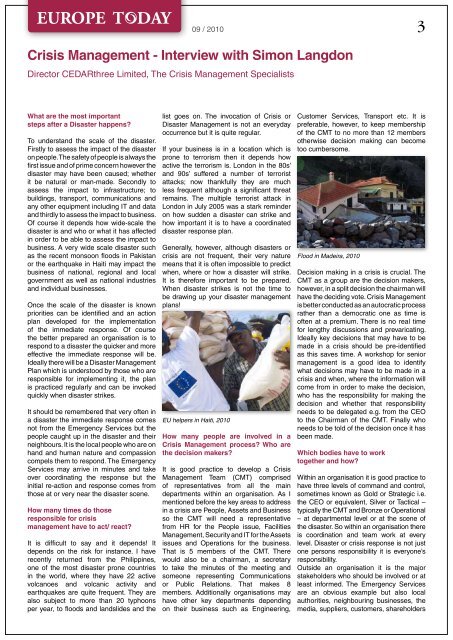Disaster ManageMent - - Europäische Akademie für Steuern ...
Disaster ManageMent - - Europäische Akademie für Steuern ...
Disaster ManageMent - - Europäische Akademie für Steuern ...
You also want an ePaper? Increase the reach of your titles
YUMPU automatically turns print PDFs into web optimized ePapers that Google loves.
09 / 2010<br />
Crisis Management - interview with simon Langdon<br />
Director CEDARthree Limited, The Crisis Management Specialists<br />
what are the most important<br />
steps after a <strong>Disaster</strong> happens?<br />
To understand the scale of the disaster.<br />
Firstly to assess the impact of the disaster<br />
on people. The safety of people is always the<br />
first issue and of prime concern however the<br />
disaster may have been caused; whether<br />
it be natural or man-made. Secondly to<br />
assess the impact to infrastructure; to<br />
buildings, transport, communications and<br />
any other equipment including IT and data<br />
and thirdly to assess the impact to business.<br />
Of course it depends how wide-scale the<br />
disaster is and who or what it has affected<br />
in order to be able to assess the impact to<br />
business. A very wide scale disaster such<br />
as the recent monsoon floods in Pakistan<br />
or the earthquake in Haiti may impact the<br />
business of national, regional and local<br />
government as well as national industries<br />
and individual businesses.<br />
Once the scale of the disaster is known<br />
priorities can be identified and an action<br />
plan developed for the implementation<br />
of the immediate response. Of course<br />
the better prepared an organisation is to<br />
respond to a disaster the quicker and more<br />
effective the immediate response will be.<br />
Ideally there will be a <strong>Disaster</strong> Management<br />
Plan which is understood by those who are<br />
responsible for implementing it, the plan<br />
is practiced regularly and can be invoked<br />
quickly when disaster strikes.<br />
It should be remembered that very often in<br />
a disaster the immediate response comes<br />
not from the Emergency Services but the<br />
people caught up in the disaster and their<br />
neighbours. It is the local people who are on<br />
hand and human nature and compassion<br />
compels them to respond. The Emergency<br />
Services may arrive in minutes and take<br />
over coordinating the response but the<br />
initial re-action and response comes from<br />
those at or very near the disaster scene.<br />
How many times do those<br />
responsible for crisis<br />
management have to act/ react?<br />
It is difficult to say and it depends! It<br />
depends on the risk for instance. I have<br />
recently returned from the Philippines,<br />
one of the most disaster prone countries<br />
in the world, where they have 22 active<br />
volcanoes and volcanic activity and<br />
earthquakes are quite frequent. They are<br />
also subject to more than 20 typhoons<br />
per year, to floods and landslides and the<br />
list goes on. The invocation of Crisis or<br />
<strong>Disaster</strong> Management is not an everyday<br />
occurrence but it is quite regular.<br />
If your business is in a location which is<br />
prone to terrorism then it depends how<br />
active the terrorism is. London in the 80s’<br />
and 90s’ suffered a number of terrorist<br />
attacks; now thankfully they are much<br />
less frequent although a significant threat<br />
remains. The multiple terrorist attack in<br />
London in July 2005 was a stark reminder<br />
on how sudden a disaster can strike and<br />
how important it is to have a coordinated<br />
disaster response plan.<br />
Generally, however, although disasters or<br />
crisis are not frequent, their very nature<br />
means that it is often impossible to predict<br />
when, where or how a disaster will strike.<br />
It is therefore important to be prepared.<br />
When disaster strikes is not the time to<br />
be drawing up your disaster management<br />
plans!<br />
EU helpers in Haiti, 2010<br />
How many people are involved in a<br />
Crisis Management process? who are<br />
the decision makers?<br />
It is good practice to develop a Crisis<br />
Management Team (CMT) comprised<br />
of representatives from all the main<br />
departments within an organisation. As I<br />
mentioned before the key areas to address<br />
in a crisis are People, Assets and Business<br />
so the CMT will need a representative<br />
from HR for the People issue, Facilities<br />
Management, Security and IT for the Assets<br />
issues and Operations for the business.<br />
That is 5 members of the CMT. There<br />
would also be a chairman, a secretary<br />
to take the minutes of the meeting and<br />
someone representing Communications<br />
or Public Relations. That makes 8<br />
members. Additionally organisations may<br />
have other key departments depending<br />
on their business such as Engineering,<br />
3<br />
Customer Services, Transport etc. It is<br />
preferable, however, to keep membership<br />
of the CMT to no more than 12 members<br />
otherwise decision making can become<br />
too cumbersome.<br />
Flood in Madeira, 2010<br />
Decision making in a crisis is crucial. The<br />
CMT as a group are the decision makers,<br />
however, in a split decision the chairman will<br />
have the deciding vote. Crisis Management<br />
is better conducted as an autocratic process<br />
rather than a democratic one as time is<br />
often at a premium. There is no real time<br />
for lengthy discussions and prevaricating.<br />
Ideally key decisions that may have to be<br />
made in a crisis should be pre-identified<br />
as this saves time. A workshop for senior<br />
management is a good idea to identify<br />
what decisions may have to be made in a<br />
crisis and when, where the information will<br />
come from in order to make the decision,<br />
who has the responsibility for making the<br />
decision and whether that responsibility<br />
needs to be delegated e.g. from the CEO<br />
to the Chairman of the CMT. Finally who<br />
needs to be told of the decision once it has<br />
been made.<br />
which bodies have to work<br />
together and how?<br />
Within an organisation it is good practice to<br />
have three levels of command and control,<br />
sometimes known as Gold or Strategic i.e.<br />
the CEO or equivalent, Silver or Tactical –<br />
typically the CMT and Bronze or Operational<br />
– at departmental level or at the scene of<br />
the disaster. So within an organisation there<br />
is coordination and team work at every<br />
level. <strong>Disaster</strong> or crisis response is not just<br />
one persons responsibility it is everyone’s<br />
responsibility.<br />
Outside an organisation it is the major<br />
stakeholders who should be involved or at<br />
least informed. The Emergency Services<br />
are an obvious example but also local<br />
authorities, neighbouring businesses, the<br />
media, suppliers, customers, shareholders

















